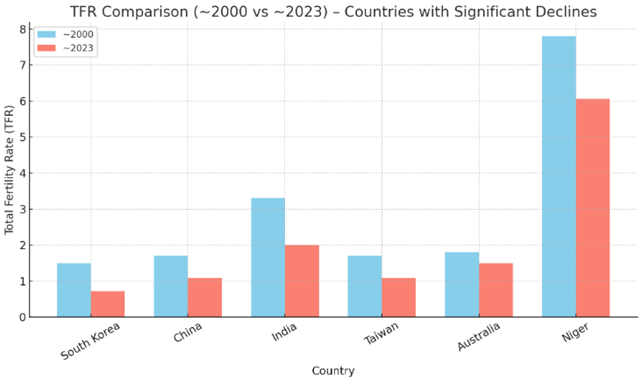I was inspired to write this piece after I read a fascinating article. It claimed that the primary driver in the current worldwide crash of fertility is status driven, with other areas playing some, but limited roles. These other areas mentioned in mainstream circles are typically economic issues, housing quality and access, and maternity leave.
By themselves, these issues alone are an absurd explanation for the collapse in fertility. When 6+ children families were the norm in history, conditions were horrific by modern standards. In dissident right circles, feminism, a lack of religiosity, and crumbling social cohesion (largely caused by immigration) are also blamed. These are all valid points, but do not get to the heart of the issue either as the numerous studies have indicated. I highly recommend reading (or listening to) this article as it goes into much more detail, but I will give a brief description below.
Findings of the Article
The article makes the argument that modern liberal norms have made motherhood low-status and socially unacceptable, which is the main cause of collapsing birthrates. The financial incentives offered in countries like South Korea, Sweden or Hungary have only limited effectiveness. In the case of South Korea, they have spent approximately $270 billion USD in initiatives aimed at boosting childbirth. As their current birthrate is approximately 0.8 per woman, this policy has clearly been a dismal failure, and the collapse must be explained via other methods.
The article’s underlying idea is that a woman can attain more prestige in modern society by having a career, money, independence, good looks… all of these things that are, yes, somewhat reduced by having children, and particularly more than 2. This is to the extent that many women are assumed to go back to work as soon as possible after having children (even as early as a few months!), as if working is the most important thing that women can do, instead of raising her children in a healthy environment.
Women are put into a difficult situation here, as their most fertile and healthy years are in their youth, when they are most desirable to men. However, the schooling system is set up to encourage them to have a career instead, so there is a direct conflict between these two. Many women put off having a family (or even serious partnerships) until they are older. Here, they often find out that they are too old, or that men are no longer interested, or that the men who waited in the pursuit of their own pleasures are not of good character to be suitable fathers. They rarely have enough time left to have more than a replacement birthrate (making up for their co-careerists who weren’t able to reproduce).
Births at the rate of 2.1 per couple is the absolute minimum for population replacement, after taking into account all those who cannot have children due to infertility, early death, homosexuality, etc. If your sibling and their partner aren’t having children due to one of those reasons, in order to provide a replacement, you would need to have 4 or 5 children just to break even within your family. Once this dynamic is understood, the precariousness of our situation becomes evident: we have a population time-bomb.
This situation is dire. People globally are having so few children, it’s not just a Western disease any longer: the East Asians are hit even harder than we are. Here’s a graph showing some of the extreme drops in fertility since 2000:

Note that that this collapse is happening everywhere, even in India and Niger. Exact stats on TFR numbers change depending on where you look, so take the numbers as an indication only.
For serious mainstream solutions, we are left wanting. For liberals, Sweden and France are often held up as the golden standard for pro-natalist policies, but even with Sweden’s 480 days of paid parental leave for mothers (and 90 for fathers), their birthrate is still only 1.7. After taking into consideration the ‘new Swedes’ and their higher birthrates, this is not something to be boasting about! Even on the dissident right, Hungary’s longstanding conservative government spends 5% of its GDP on pro-natalist incentives. After 15 years, the results are in: Hungary has only managed to increase its fertility by 0.2, to ~1.6 per woman. Reversing the decline is notable, but this still isn’t enough.
The end of the linked article makes a few suggestions on how to reverse this trend, but even these moderate policies are so fundamentally anti-liberal that our overlords are unlikely to accept them (even in part). They call for removing state policies that enforce liberal education, gender equality, and diversity, which would allow traditional, religious, and family-centred communities to thrive without interference. While framed primarily as ‘liberals can continue to do their thing, as long as others are able to do theirs’ (which is essentially a liberal idea), this is a loss of power and control that the liberals will not take lightly.
The Problem, Expanded
It is of course true that women have more to offer than having and raising children, though this is arguably the most important thing that most women ever do. The point of the article (and this piece) is not to belittle women for their choices and desires in life overall, but to encourage within women a desire to have more children organically, first by understanding where the problem lies (status), then identifying solutions, and finally ways of implementing those solutions.
There are two points I would like to expand upon from the article.
One: The article does overstate women’s impact on fertility. In more traditional societies, as head of the household, men had more impact on family decisions made, although all men (save the most dismal) exert some influence on their relationships. Accordingly, men must also have a key part to play in the desire for larger families. Men historically gained some status from rearing children, but this too has become undervalued in modern liberal society. Good fathers are almost as tied to the family as mothers are, with a great loss of freedom which equates to a situation now where there is no status gain for having children, only a perceived burden which is curtailing the interest of men, in much the same way as women in raising children.
Although amongst conservative religious circles, it is increasingly a point of status to have children, this can always be enhanced and expanded to the broader Australian nation. Nativists must do all that we can to elevate the status and the prestige of parenthood. Fathers and mothers must be shown a heightened level of regard, respect and admiration amongst the community in order to make the undoubted sacrifice of parentage something more gladly accepted.
Two: Optimism for the future is another very important step for parents in considering if they want children, and how many they have. This could be optimism over the destiny of a nation, religion or subcultural group. A common refrain heard is “Kids? With the way the world is going?”, or “We’ll all be underwater in 40 years, how can I bring children into that?”. Economic pessimism, climate alarmism, and the subconscious awareness in the masses that we are a civilisation in decline all play a big role as well. Increasing hope for the world through various means is therefore another key step in increasing fertility.
It should be mentioned that yes, perhaps the time for 6+ children per family has passed, that it is no longer strictly required in the world we live in. In the West, child mortality rates have plummeted, large scale war is rarer, famine is gone, and the state has taken over the responsibility of caring for the elderly in the form of superannuation and pensions (to a large extent). However, I find it hard to believe that even with significant technological advancement, that the need for children will decline much further. Where will this road lead us?
As important as the technical and statistical aspects of this field is, the metaphysical aspects are, arguably, more important. The only reason I haven’t gone into more detail here is because it is not the point of the article, however it would be remiss of me to not mention it in brief.
Children are the soul, the future, and the hope of a nation! It exists, works, and thrives due to it’s families. The fewer children present, the less civic interest and future thinking within that nation. A nation that is not growing is contracting, and I would rather see 40 or 60 million White Australians than 4 or 6 million (though of course, these Australians should be of good quality). I see no reason why Australia cannot be a great nation. However, before we think of Imperium, we must think of the nuts and bolts: how do we fix this issue?
Solutions from an ANA perspective

Approaching this as Nativists, there is little we can realistically do with our level of influence in broader politics and culture. The birthrate revival we want (and require) in Australia will be a heroic effort, part of an immense cultural shift which is likely to be out of our control. A precursor to this change will likely be a population collapse, or after a major war or economic crash, as priorities are shifted within the populace.
Complaining is a good first step, but what can we actually do about this? Well as a part of a broader Nativist-led cultural revival, we can raise the status and prestige of parentage by:
– Encourage families as a key part of our platform, on a level equalling our other central platforms (such as national homogeneity, cultural education, and economic reforms).
– Provide financial support to members of our Association who have children (this is already a policy in some branches).
– Provide rewards, awards and recognition to parents for larger Australian families across the country, regardless of their affiliation with ANA.
Most importantly, starting tomorrow the ANA can:
– Send congratulations to first time mothers for the wives of members on the birth of their children, combined with presents and offers of personal help from the local branch.
– Present non-competitive yearly spotlights on mothers who have achieved something significant. So as to not contribute to this ‘motherhood status’ issue, it should be on things either complimentary to motherhood or directly related, such as creating a homeschooling curriculum, or how they contribute to their local community.
– Present small opportunities for the wives of ANA men to speak on their experiences of motherhood, and their motivations for children, if they wish.
– Provide recognition and appreciate of men for their role as fathers, in addition to the above.
It may be that some of these ideas won’t work to affect broader society in any significant way. However, this uncertainty of success is true for any endeavour, and it should not hinder the attempt.
While technology will likely continue to reduce the need for as many children as we had traditionally, repairing these birthrates to at least a sustainable level is critical for our survival as a culture and people. If nothing is done, then we risk becoming functionally extinct within 100 years, if the numbers continue to decline at this rate.
We shouldn’t totally lose hope, though. Without modern technology, the Amish have increased from around 5000 in 1920, to 166,000 in 2000, to over 400,000 in 2024. If those trends continue (however unlikely), America will be speaking in Pennsylvania Dutch within a century! The solutions are all achievable, we just need the courage and will to enact them. So next time you see a large Australian family with kids, give them a smile and show your appreciation. Offer your friends and family assistance! Get involved with ANA, and be a part of the broader Australian cultural revival.
Thomas M.
Governor – ANA Victoria
2025
